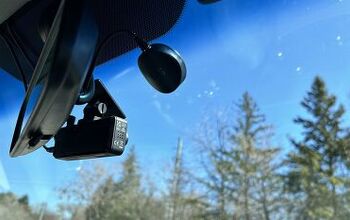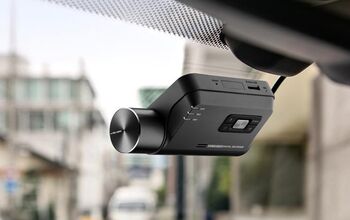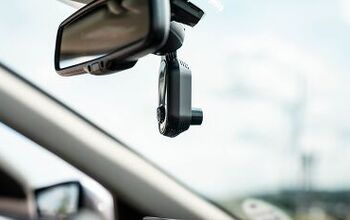Thinkware ARC Dash Cam Review

Like our parents always told us, it's better to see a situation from other perspectives. That's true in the world of dash cams too.
In my life, I've been a passenger during three car accidents. In each case, the car I was riding in was rear-ended; in every case, the person who crumpled the back bumper would argue we stopped suddenly. Even one time when we were stationary for a full 10 seconds before impact...
Dash cams are increasingly common today, giving drivers a rock-solid record of what went down directly before potential accidents. Setups that include a second camera to give the view behind as well as in front tell a more complete story. To have a dual-camera setup is to quite literally protect your own butt.
With the amount of driving required in this job, not to mention so much time spent behind other peoples' cars, I wanted to invest in exactly this sort of dash cam. As luck would have it, Thinkware reached out to offer me one of its ARC models for testing. After months of use across multiple vehicles, day and night, and rain, snow or shine, here's what I found.
Easy Install, Lots of Wires
The Thinkware ARC is a full-feature, dual-channel dash cam. A 2.7-inch touchscreen on the back provides a basic interface on the unit itself, and footage from both cameras is a useful 1440p at 30 frames per second.
The ARC comes with a full complement of accessories beyond the two cameras. There's a GPS unit for starters, along with the traditional 12V power supply as well as more permanent wiring solutions, which Thinkware recommends professional installation for. The mount is the 3M semi-permanent sticky sort; not ideal for my use case, but likely for yours. I found the front mount fairly easy to reseal and move to the next car, while the rear camera's pad is very eager to find a spot and set up shop, even though it's smaller. Once placed, the rear camera can simply be rotated to get the right view.
Another challenge for my needs: there are a lot of wires here. The 12V is expected, so no issues there. The rear camera becomes a little tougher to snake through a cabin or hide, but again, it's a one-time thing for most peoples' needs. The GPS unit is an additional third wire sprouting out of the main unit however, and that does start to create clutter.
Companion App is Handy, But Not Required
Like so many aspects of life these days, the Thinkware ARC has a companion app. And for a while, I couldn't get it to work.
Only part of that was operator error; I found a guide on Thinkware's website to walk me through a handful of settings I needed to change on my phone to get things working. From there however, there was a speedbump: the touchscreen displays a QR code to connect to its WiFi, while the phone app utilizes one of the phone's cameras that can't handle something that close. The only alternative is to manually enter in the Wifi info; not a deal-breaker, but poorly realized nonetheless.
Once hooked up, the phone app allows a user to adjust any of the camera settings that can be dealt with via the touchscreen. Better still, one can download any and all videos directly to their own phone from the (included) Micro SD card, no transfer fuss necessary. This was made a little more complicated for me because, again, different cars, which reset the internal clock on the main camera and muddled the order. It's possible to review and delete anything from the camera's memory during this step however, which is handy.
One thing I couldn't find in the companion app was a live view feed. This isn't too bad for the front camera, but it does make adjusting the rear camera more trial-and-error than I'd like. Also of note: the camera's back screen is essentially useless with polarized glasses.
Naturally, pairing the phone up to the camera means no Apple CarPlay or Android Auto. The good thing here is that there's no reason to keep it paired beyond the initial setup; in fact, you could never pair a phone and still get all the functionality thanks to the camera touchscreen—though I do find some menus tough to navigate due to the screen size. The main benefit is the easy file transfer.
Image Quality: Great in the Day, Fine at Night
I used the ARC across a variety of vehicles, including small SUVs, huge SUVs, sports cars, and electric vehicles (EVs). Aside from the finnicky rear camera placement, they performed very well... in the day time.
Both cameras have a 125-degree field of view, and the image quality is uniformly great, without much of a dip towards the edges of the picture. There is no issue reading license plates or even figuring out where another driver is actually looking. A built-in microphone captures in-cabin audio, though you can turn that off.
At night, image quality suffers, with lots of light glare and a generally muddy picture. It's good for broad strokes stuff, but that's all.
Additional Features
Unlike something smaller like the Garmin Dash Cam Mini 3, the Thinkware ARC has quite a lot of additional features. These include a parking mode to record when you aren't driving, complete with options to adjust motion tracking sensitivity, off time, and voltage limits. There are also active driver assists, including a front vehicle departure warning and traffic signal alert. These are admittedly rudimentary, but if you are driving an older car without its own suite of assists, they can prove helpful.
Like many other dash cams, the ARC can automatically highlight a recording with an incident. I found it's middle sensitivity setting still too eager to classify things like speed bumps as incidents however; your mileage may vary. There's also a Super Night Vision mode to eke out some more detail at night, but its performance was inconsistent.
Lastly, while there are voice alerts, there is no voice command feature.
Final Thoughts
The Thinkware ARC proved to be a versatile two-camera setup with excellent daytime image quality and great smartphone integration (once I figured out the right settings). It's not the ideal setup for someone who gets in and out of different cars on the regular, but if you're looking for a semi-permanent solution for when you're on the road (and when you're not), the ARC is a complete package.
Become an AutoGuide insider. Get the latest from the automotive world first by subscribing to our newsletter here.

Kyle began his automotive obsession before he even started school, courtesy of a remote control Porsche and various LEGO sets. He later studied advertising and graphic design at Humber College, which led him to writing about cars (both real and digital). He is now a proud member of the Automobile Journalists Association of Canada (AJAC), where he was the Journalist of the Year runner-up for 2021.
More by Kyle Patrick







































Comments
Join the conversation